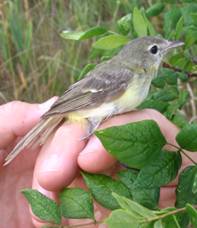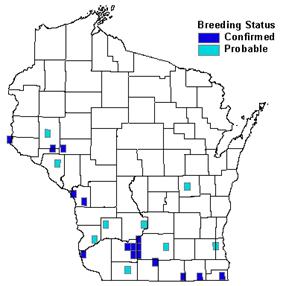

Status/Protection
- Global Rank: G5 Key to global and state ranks
- State Rank: S2B
- WBCI Priority: SGCN, State Threatened
Population Information
The Federal BBS information can be obtained at http://www.mbr-pwrc.usgs.gov/bbs/bbs.html by clicking on Trend Estimates and selecting the species in question. All estimates are for time period (1966-2005).
*Note: There are important deficiencies with these data. These results may be compromised by small sample size, low relative abundance on survey route, imprecise trends, and/or missing data. Caution should be used when evaluating this trend.
- Federal Breeding Bird Survey: significant decline
- Federal Breeding Bird Survey (WI): non-significant decline*
- Federal Breeding Bird Survey (BCR 23): non-significant decline*
- Federal Breeding Bird Survey (BCR 12): N/A
- WSO Checklist Project: significantly increasing (1983-2007)
Life History
- Breeding Range: Southern California and Nevada east across northern Mexico and the Great Plains states (Brown 1993).
- Breeding Habitat: Grassland-shrub.
- Nest: Cup suspended between fork in shrub.
- Nesting Dates: Late May – early July.
- Foraging: Glean and hawk insects in shrubs.
- Migrant Status: Long-distance migrant.
- Habitat use during Migration: scrubland, riparian areas, and woodlands.
- Arrival Dates: May.
- Departure Dates: August-September.
- Winter Range: Mexico to Costa Rica.
- Winter Habitat: Tropical deciduous forest and arid scrub forest.
Habitat Selection
Bell ’s Vireos nest in shrub or sapling clumps or shrubby edges/hedgerows adjacent to grasslands or in riparian habitat. If adequate shrub content is present (5-30%) Bell’s Vireos may also be found in pastures, idle grasslands, old fields, native prairies, oak savannah, sedge meadows (Sample and Mossman 1997) hedgerows and power line right of ways (Knutson et al. 2001). Bell’s Vireos are absent from intensively cultivated areas, forests, and pure grasslands (Brown 1993). They prefer dense thickets with high stem density and other cover, such as climbing grape vines and tall grass against the thicket margins, which provides good nest concealment in the zone 2-6 foot from the ground. Prickly ash, American wild plum, and American hazelnut appear to be favored species, but many species of shrubs and small trees are used. Nests are usually 2-5 feet high in the shrubs (Robbins 1991).
Habitat Availability
Wisconsin is along the northeastern edge of the Bell’s Vireo’s breeding range and vireos are found in scattered clusters in southern and western Wisconsin (Robbins 1991). Currently the core Bell’s Vireo population probably exists in the southwest savanna ecological landscape in Iowa, western Dane, Lafayette and Green counties. Pastures and old fields are common in this area of the state but vulnerable to conversion to row crop, hay fields, and urbanization. Idle grasslands, native prairie, oak savanna, and sedge meadows are rare and also vulnerable to conversion. Available habitat in grasslands is further restricted by the need for shrubs for nesting which not all grassland habitats are going to have (Sample and Mossman 1997). It’s not clear if grassland acreage or shrub availability is currently limiting Bell’s Vireo populations.
Maintenance of the Grassland-shrub habitat type has not historically been a priority and is often overlooked in bird conservation planning. Many hedgerows have succeeded to mature trees or removed to create larger fields. Power line right-of-ways are currently the most stable habitat, but difficult to maintain in a suitable condition for Bell’s Vireos with their long narrow shape (Knutson et al. 2001).
Population Concerns
Bell ’s Vireo is undergoing a range-wide decline and needs sufficient shrub-grass habitat to maintain the population. If not, the Bell’s Vireo may become extirpated from the edges of its range, including Wisconsin (Knutson et al. 2001). Currently Bell’s Vireos are not well-monitored by traditional monitoring systems including the Wisconsin Breeding Bird Atlas. This is partly due to the low numbers of birders in the range of this species coupled with the fact that much of the Bell’s Vireo population resides on private lands (Sample pers. comm.). Development pressure, intensification of agriculture, loss of hedgerows and shrub habitat, and loss of grasslands all contribute to this species’ State Threatened status. In addition, parasitism from Brown-headed Cowbirds is also a concern in agricultural landscapes. Brown-headed cowbird parasitism causes nest abandonment (Kus 2002, Bent 1950) and reduces overall nest productivity. Parasitized nests that are not abandoned are less productive. If this parasitism becomes excessive, it can lead to population declines in even the best habitats (Brown 1993).
Recommended Management
Conservation opportunities exist for managing Grassland-shrub communities in a number of different grassland/agricultural habitat types. It’s important to recognize that shrub communities don’t have long-term stability in one specific location and aren’t seen as valuable to most landowners. Large scale land use practices (forestry and agriculture) that maintain adequate acreage of shrub habitat over the whole landscape, even if not in the same spot, may be more practical in some areas (Knutson et al. 2001). In areas where landscape management isn’t practical, grassland management techniques that maintain a shrub component can be effective. In prairie/grassland settings, keeping a limited amount of prickly ash, plum, and other shrubs in ravines, draws, and other low topographic locations may be effective. It appears that multiple clumps of brush in close proximity may be preferred habitat over a large single clump.
Burning is an effective tool for maintaining grassland. However; to keep an adequate shrub component for Bell’s Vireo, modifications of management methods and approaches may be needed. For example, a longer burn rotation in some locations (once every 5+ years) may be helpful. However, long rotation fires of 5 + years may not adequately sustain the desired mix of brush/grass habitat long-term. It might be better to protect selected brush patches within an area that is maintained as grassland with fire, grazing, or mowing. Light to moderate grazing can be helpful in maintaining grassland without eliminating shrub patches. However, if tall grass against the brush is an important concealment, future grazing may compromise that structure (Sample and Mossman 1997). Encouraging restoration and timely management of hedgerows in agricultural/rural areas will probably benefit this species, as well as a number of other priority species.
Research Needs
Surveys designed for Bell’s Vireos and other grassland/shrubland birds are needed to establish more definitive population trends for the state. If generating population trends isn’t possible, then targeted surveys to track changes in abundances and distribution will be needed for continued protection. Recent fieldwork in limited locations suggests that they may be more widespread than previously thought (Sample pers. com.). Survey data can be used to determine if the breeding areas are maintaining their populations and can be used to evaluate management of grassland ecosystems. Of particular interest is designing a management scheme that removes treelines for grassland birds but retains shrubs for this species. Any Grassland-shrub management scheme should be evaluated to determine success with respect to occupancy, nesting success (cowbird parasitism) and presence of other shrubland priority species (Field Sparrow, Brown Thrasher, Northern Bobwhite, Loggerhead Shrike, etc.). It’s unclear how important adjacent grassland/agricultural habitats are to Bell’s Vireo demographics. Much remains to be studied about this species’ distribution and survival on wintering grounds and during migration (Brown 1993).
Information Sources
- David Sample, Grassland Community Ecologist, Wisconsin DNR Research Center, 1350 Femrite Dr., Monona, WI 53716.
- North American Breeding Bird Survey: http://www.npwrc.usgs.gov
- Temple S. A., J. R. Cary, and R. Rolley. 1997. Wisconsin Birds; A Seasonal and Geographical Guide. Wisconsin Society of Ornithology and Wisconsin Department of Natural Resources, Madison, WI.
- Wisconsin Breeding Bird Atlas: http://www.uwgb.edu/birds/wbba/
- Managing Habitat for Grassland Birds: A guide for Wisconsin
References
- Bent, A.C. 1950. Life Histories of North American Wagtails, Shrikes, Vireos, and Allies. Smithsonian Institution United States National Museum Bulletin 197.
- Brown, B. T. 1993. Bell’s Vireo. In The Birds of North America, No. 35 (A. Poole, P. Stettenheim, and F. Gill eds.). Philadelphia: The Academy of Natural Sciences; Washington, DC: The American Ornithologists’ Union.
- Knutson, M. G., G. Butcher, J. Fitzgerald, and J. Shieldcastle. 2001. Partners in Flight Bird Conservation Plan for The Upper Great Lakes Plain (Physiographic Area 16). USGS Upper Midwest Environmental Sciences Center in cooperation with Partners in Flight. La Crosse, WI.
- Robbins, S. D., Jr. 1991. Wisconsin Birdlife: Population and Distribution Past and Present. Madison, WI: University of Wisconsin Press.
- Sample, D. and M. Mossman. 1997. Managing Habitat for Grassland Birds: A Guide for Wisconsin. Wisconsin Department of Natural Resources: Madison, WI.
Contact Information
- Compiler: Jenny Herrmann, mherrmann@wi.rr.com
- Editor: Richard Henderson, richard.henderson@dnr.state.wi.us
